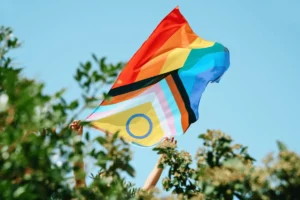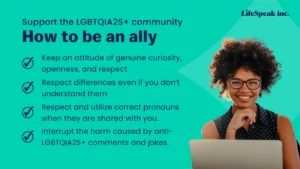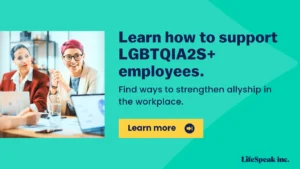Expert Voices: Celebrating Pride Month – How to Build an Inclusive Workplace Culture
Expert Voices: Celebrating Pride Month – How to Build an Inclusive Workplace Culture
June is Pride Month, a time to celebrate the LGBTQIA2S+ community and its vibrant diversity. But Pride is much more than a celebration; it’s a call to action for inclusivity and a reminder of the ongoing journey for equal rights.
This year, let’s commit to building an inclusive workplace culture that reflects that support. Let’s choose inclusive language, celebrate diverse identities, and take concrete steps to support our LGBTQIA2S+ colleagues.
To explore the question of why celebrating Pride Month is more important than ever, we turn to LifeSpeak Inc. expert David Brandon Flynn, certified coach, facilitator, and DEI professional. David shares his insights to help understand the rich history of the LGBTQIA2S+ rights movement and why embracing intersectionality and practicing allyship can create workplaces where everyone feels respected, valued, and empowered to contribute their unique talents.
It’s arguably one of the most colorful times of the year. The rainbow flag in its various iterations joyfully appears, adorning shop windows, street banners, themed celebrations, advertising, and social media campaigns. Some cities host parades and events that attract hundreds of thousands, if not millions, to celebrate together; not only invigorating local economies but also providing a platform from which to communicate a message. And what is that message? PRIDE.
Pride is a celebration of the two-spirit, lesbian, gay, bi, trans, queer, intersex, and asexual or LGBTQIA2S+ community, the lives that we have, and who we are. But Pride is much more than a celebration. It is also, very importantly, a time for reflection, remembrance, learning, and action. And Pride today may be more important than ever.
In this article:
Why Pride is important to me

There are a few reasons why I believe this to be true. But let me start with why Pride is so important to me, personally.
This year, I turned 42 years old. I identify as a gay, cisgendered male. And while that isn’t the entirety of who I am, it is an important, beautiful, and fundamental part of who I am. My life has taken place over the last four decades, and during that time, I’ve had the privilege of watching the LGBTQIA2S+ rights movement progress along an incredible trajectory.
As a kid in the 80s, alone in my room, I would cry and pray to God to not make me “that”. I had no support, community, or representation at that time and didn’t even have the language to identify what I felt or what I was. But I knew I wouldn’t want to be it. Fast forward to the 2000s, where I saw two decades in which it felt like LGBTQIA2S+ rights could only improve. I saw resources and access to resources increase. I saw representation of LGBTQIA2S+ people in media expand to where it now feels common, and even mainstream. We’ve seen marriage equality become a reality, currently in 34 countries across the globe. We see LGBTQIA2S+ representation in sports, politics, and business. There is still so much to do, but for many people in the LGBTQIA2S+ community, we can have lives with freedoms that generations prior couldn’t have imagined.
The last few years, however, have felt different. All of the rights that our global community has fought so hard for, feel very much at risk. I feel fear and uncertainty about the future that I haven’t felt for a very long time. It’s for this reason that Pride this year is an incredibly important one.
“Pride is not only a celebration. Pride is the rallying cry from a community choosing to take a stand for the right to exist and to claim equal human rights”
Understanding Pride
I’ve heard the question posed from time to time as to why we even need a LGBTQIA2S+ Pride Month, and why isn’t there a straight Pride?
I encourage everyone to research the rich history ofLGBTQIA2S+ communities and activists, and I would like to highlight that Pride as we know it today came from resistance. Standing on the shoulders of many queer rights organizations before them, queer folks started to resist the discrimination and violence that they had endured. In the U.S. in 1969, it was common for queer spaces to be raided by the police and for queer and gender non-conforming people to be thrown in jail simply for existing. One summer night that year, at the Stonewall Inn in New York City, one such police raid occurred. Led predominantly by Black and trans women, the patrons at the Stonewall Inn resisted the police and fought back. This sparked the Christopher Street Liberation Day demonstration the following year, publicly advocating for gay rights and evolving into the annual Pride March and Pride Month as we know them today.
Pride is not only a celebration. Pride is the rallying cry from a community choosing to take a stand for the right to exist and to claim equal human rights.
“Each of us is an expression of the rich tapestry of our identities which include our race, gender, sexual orientation, ability/disability, age, cultural background, and many more.”
An intersectional lens: a more inclusive Pride
We can’t talk about Pride without also discussing the diversity within the community. Each letter in the LGBTQIA2S+ acronym represents a social identity. The “+” sign at the end of the acronym is there to be inclusive of all related groups not currently represented in the most commonly used acronyms. The histories, backgrounds, and experiences of each of these groups are special and unique. The human beings within these social identities are also not only defined by their sexual or gender identity. This is why it is important to consider the intersectionality of Pride.
Intersectionality is a term coined in 1989 by American critical legal race scholar Kimberlé Crenshaw. It is a term used to articulate how within any one person, there are multiple social identities. None of us is only one thing. These social identities intersect and create who we are. Each of us is an expression of the rich tapestry of our identities which include our race, gender, sexual orientation, ability/disability, age, cultural background, and many more.
Depending on where we are located in the world and our social environment, some of our social identities will have innate privileges, and other identities may experience disadvantages.
This concept can help us to understand why, for example, the experiences I’ve had as a White, cisgender, gay man will differ greatly from a Black, transgender woman. While I have experienced challenges and discrimination due to my gay identity, I’ve also had many unearned privileges afforded to me due to being a White, cisgender male. Privileges not afforded to my Black, transgender counterpart who experiences compounded disadvantages just for being who she is. A better Pride is about listening to people when they tell us who they are and what their experiences have been.
A better Pride is also about believing in them and finding better ways to respect each other as human beings.
“Keeping an attitude of genuine curiosity, openness, and respect is key.”
How to be an ally
With our understanding of intersectionality, we can see how there is no single approach to being an ally. Allyship is very much needed and welcome but can cause more harm than good when done incorrectly.
Here are a few points to consider when wanting to support the LGBTQIA2S+ community as an ally and a friend.
- Keeping an attitude of genuine curiosity, openness, and respect is key.
- Allyship is an action and a lifelong process, not a label you can give to yourself.
- Respect differences even if you don’t understand them. Understanding is not required to treat others fairly and with respect.
- Respect and utilize correct pronouns when they are shared with you. Consider getting into the habit of sharing your own pronouns as this signals a safe space to do so and can encourage others.
- Continue your own learning and explore your own unconscious biases.
- Interrupt the harm caused by anti-LGBTQIA2S+ comments and jokes. It is enough to say, “I don’t find that comment appropriate/funny. Please don’t make remarks like that.”, for example.
- Don’t assume the identities of others. You never know how someone may identify themselves, or if they have family or close friends who are LGBTQIA2S+.

“It is important to proactively choose our language so that we may reap the benefits of an inclusive workspace.”
Inclusive language and building an inclusive workplace culture
Language is powerful. It can make us feel welcome, accepted, and able to contribute fully or the complete opposite. Contrary to the old adage that “sticks and stones may break my bones, but words will never hurt me,” we now know that, in fact, words can and do cause harm. It is important to proactively choose our language so that we may reap the benefits of an inclusive workspace.
Here are just a few examples of language we can shift to be more inclusive:
- Ladies and gentlemen / Guys and gals -> Colleagues, team, everyone
- Maternity and paternity leave -> Parental leave
- Husband, wife, boyfriend, girlfriend -> Partner, spouse
- What are your preferred pronouns? -> What pronouns do you use? (A person’s pronouns are not preferential.)
- As with the language we use, the environments that we create and the work that we present to each other and to the world at large can equally cause people to feel included or excluded.
Here are a few examples of more practices to build an inclusive workplace culture:
- Set up a LGBTQIA2S+ Employee Network or Resource Group
- Review Company Policies, Benefit Programs, and Hiring Practices to ensure inclusivity
- Provide LGBTQIA2S+ Training to increase general awareness and understanding
- Opt for gender-neutral toilet facilities
- Celebrate LGBTQIA2S+ history and events
- Avoid rainbow washing: This is where an organization pushes an image of LGBTQIA2S+ inclusion through superficial product placement or branding while having no substantial inclusion practices that support the community
This year, as we continue to see headlines that impact the LGBTQIA2S+ community, my hope is that we can increase our ability to see the humanity in each other, be curious about our stories, and have a little more empathy and respect for each other. Each of us makes choices every day on who we will be and the impact we will have.
So, who will you be? And what actions can you take to make a better, more inclusive world, right from where you are today?
Looking to create an inclusive workplace culture? LifeSpeak Holistic Wellness delivers a wide range of resources to support your DEI initiatives at all levels, including LGBTQIA2S+ at work and beyond.
To learn more about our full suite of solutions, request a demo today.
About the author, LifeSpeak Inc. expert David Brandon Flynn
 David is a certified coach, facilitator, and DEI professional with a diverse background who specializes in delivering quality people and team development initiatives. He has over 15 years of experience working with businesses (lululemon, Tokyo International School) and organizations (Towada City Board of Education, JET Programme) in developing their people towards their fullest potential.
David is a certified coach, facilitator, and DEI professional with a diverse background who specializes in delivering quality people and team development initiatives. He has over 15 years of experience working with businesses (lululemon, Tokyo International School) and organizations (Towada City Board of Education, JET Programme) in developing their people towards their fullest potential.
David recently completed his Executive MBA with the Quantic School of Business and Technology as well as two coaching certifications through the Co-Active Training Institute (CPCC) and the International Coaching Federation (ACC) with which he is also a member. David also has certifications in Training (ATD), Human Performance Improvement (ATD), Indigenous Studies (University of Alberta) and Mental Health First Aid (Mental Health Commission of Canada).


